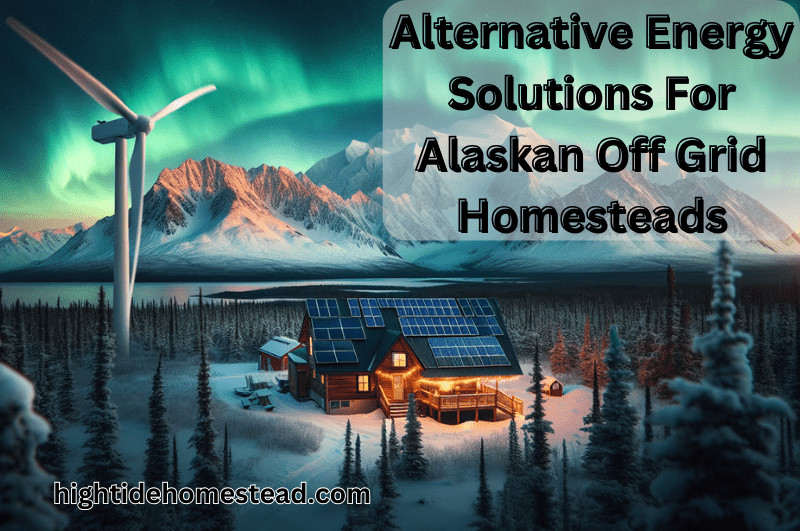High Tide Homestead participates in affiliate programs and may earn commissions from qualifying purchases on this post. See our Disclosure page for more information.
Harnessing solar power in the Land of the Midnight Sun
Despite the common misconception that Alaska suffers from an eternal winter, when averaged over the year Alaska gets 10-17 minutes of sunlight more each day than other states. And our summers are graced with nearly endless daylight. That means alternative energy in the form of solar panels is a great choice for off-grid homesteads here. Solar panels are incredibly effective during these extended periods of sunlight, providing ample energy to sustain a homestead’s needs.
Alaskan homesteaders can optimize their energy collection by strategically placing solar panels, even during the shorter days of winter. This includes using technology like bifacial panels horizontally to capture sunrise and sunset hours. Some places even use tracked panels that follow the sun’s movements across the sky. Advances in battery technology, such as LifeP04 batteries, allow energy to be stored efficiently for use during darker periods or long winter nights. Newer batteries even have cold protections, which are important in climates that freeze half the year. Modern solar systems are designed to be robust and withstand the harsh Alaskan elements, ensuring a reliable energy source throughout the year. Panels even collect some power through cloud cover and small amounts of snow.
No-Scratch Snow Removal Foam Sno Brum (Amazon affiliate link)

Wood-Fueled Biomass as Alternative Energy?
The use of biomass for heating cannot be overstated during Alaskan winters. Trees are a renewable resource, and with responsible management, wood can be harvested to fuel stoves and boilers, providing heat without the cost of other fuels such as heating oil and propane. Wood may be more labor-intensive as a heat source, but Alaskans enjoy being outside in any weather. We even like to joke that it’s a heat source that warms more than once; while harvesting, chopping, and burning!
New technology in wood stoves allows for longer burn times and more complete combustion, reducing smoke and increasing heat output. Blaze King stoves are common in Alaska, as they use catalytic combusters which heat with 33% less wood use. And many parts of Alaska have dealt with infestations of Western Bark Beetles. The larvae of these beetles can decimate entire sections of forest in a season, leaving trees dead but standing. These trees are used for wood burning as they are pre-seasoned, and removal helps with fire safety in affected areas. There are grants for the removal of dead trees, treatment and pruning of live trees, and replanting of forests.
Larger homesteads might opt for wood-fueled boilers, which can heat multiple buildings and provide hot water as well. These are a great option for homes that want to utilize in-floor heating systems.
Pex Flexible Water Tubing (Amazon affiliate link)

Wind Energy
Alaska’s expansive landscapes are often swept by powerful winds, especially in coastal regions. Harnessing this natural resource through wind turbines can supplement a homestead’s energy supply, particularly when solar power is less effective in the winter months.
Modern wind turbines are engineered to be more efficient and durable, making them an excellent choice for homesteaders looking to diversify their energy sources. The integration of wind and solar power can often provide a continuous supply of energy, reducing reliance on generators.

Primus Air 40 Wind Turbine 12V (Amazon affiliate link)
Micro-Hydro Energy
Many Alaskan homesteads are situated near streams or rivers, providing an untapped resource in the form of micro-hydro electricity generation. By installing a small turbine in a nearby flowing water source, homesteaders can generate power with minimal impact on the environment and local ecosystems.
Biogas for Cooking
For those that already use natural gas or propane for cooking, the switch to biogas as an alternative cooking means is easy. Biogas is fuel that is produced when organic matter such as animal waste is broken down via anaerobic digestion. There are plenty of plans online for creating DIY biogas digesters, or consumer-ready kits for sale online. We have the Home Biogas system that we are planning to set up this summer. We will need to enclose the system for use in Alaska, as it needs temperatures of at least 69°F for optimal gas creation, but works as low as 41°F. The more waste that is fed into the system, the more biogas is created for use.
Embracing the Alternative Energy of Tomorrow
Alternative energy solutions are not just a choice but a necessity for the Alaskan way of life off the grid. By embracing solar, biomass, wind, and micro-hydro power, we carve out a life that respects the beauty of Alaska, while allowing us creature comforts in the harshness of our surroundings.
Documented on this blog are our adventures in living off-grid in Alaska, and all the ways we have made straying out here not just possible, but enjoyable. Join us as we continue to explore and share our adventures in living on The Last Frontier!
High Tide Homestead participates in affiliate programs and may earn commissions from qualifying purchases on this post. See our Disclosure page for more information.

3 thoughts on “Alternative Energy Solutions For Alaskan Off Grid Homesteads”